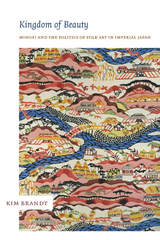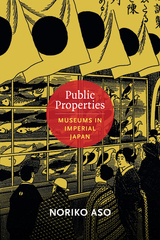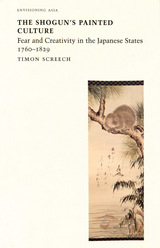
In the twelfth century, along the borders of the Japanese state in northern Honshu, three generations of local rulers built a capital city at Hiraizumi that became a major military and commercial center. Known as the Hiraizumi Fujiwara, these rulers created a city filled with art, in an attempt to use the power of art and architecture to claim a religious and political mandate.
In the first book-length study of Hiraizumi in English, the author studies the rise of the Hiraizumi Fujiwara and analyzes their remarkable construction program. She traces the strategies by which the Hiraizumi Fujiwara attempted to legitimate their rule and grounds the splendor of Hiraizumi in the desires, political and personal, of the men and women who sponsored and displayed that art.

Beginning by asking, “What is Japanese art?” this book supplies an answer so broad in its reach, so rich in detail, and so extensively illustrated as to give a reader not just a true picture, but also a fine understanding, of Japanese art. Arranged thematically, the book includes chapters on nature and pleasure, landscape and beauty, all framed by the themes of serenity and turmoil, the two poles of Japanese culture ancient and modern. Highlighting—close up and in color—outstanding examples of design and craft in prints, paintings and screens, metalwork, ceramics, wood, stone, and lacquer, Japanese Art in Detail presents each image alongside enlarged details--details that otherwise might be virtually invisible to the naked eye--thus affording intriguing comparisons between seemingly unrelated pieces. Throughout, John Reeve provides cultural context while pointing out exceptional features.
Though drawn from one extraordinary source—the British Museum—the specific objects pictured here are representative of many others in public and private collections worldwide, and offer a clear idea, both broad and particular, of what constitutes Japanese art. Most of these images, as well as many of those mentioned, are accessible electronically through the British Museum's online database, as are several tours linked to recent exhibits.

Kingdom of Beauty shows that the discovery of mingei (folk art) by Japanese intellectuals in the 1920s and 1930s was central to the complex process by which Japan became both a modern nation and an imperial world power. Kim Brandt’s account of the mingei movement locates its origins in colonial Korea, where middle-class Japanese artists and collectors discovered that imperialism offered them special opportunities to amass art objects and gain social, cultural, and even political influence. Later, mingei enthusiasts worked with (and against) other groups—such as state officials, fascist ideologues, rival folk art organizations, local artisans, newspaper and magazine editors, and department store managers—to promote their own vision of beautiful prosperity for Japan, Asia, and indeed the world. In tracing the history of mingei activism, Brandt considers not only Yanagi Muneyoshi, Hamada Shōji, Kawai Kanjirō, and other well-known leaders of the folk art movement but also the often overlooked networks of provincial intellectuals, craftspeople, marketers, and shoppers who were just as important to its success. The result of their collective efforts, she makes clear, was the transformation of a once-obscure category of pre-industrial rural artifacts into an icon of modern national style.


“Screech’s ideas are fascinating, often brilliant, and well grounded. . . . [Shogun’s Painted Culture] presents a thorough analysis of aspects of the early modern Japanese world rarely observed in such detail and never before treated to such an eloquent handling in the English language.”—CAA Reviews
“[A] stylishly written and provocative cultural history.”—Monumenta Nipponica
“As in his admirable Sex and the Floating World: Erotic Images in Japan 1700-1820, Screech lavishes learning and scholarly precision, but remains colloquial in thought and eminently readable.”—Japan Times
Timon Screech is Senior Lecturer in the history of Japanese art at SOAS, University of London, and Senior Research Associate at the Sainsbury Institute for the Study of Japanese Arts and Cultures. He is the author of several books on Japanese history and culture, including Sex and the Floating World: Erotic Images in Japan 1700–1820 (Reaktion, 1999).

READERS
Browse our collection.
PUBLISHERS
See BiblioVault's publisher services.
STUDENT SERVICES
Files for college accessibility offices.
UChicago Accessibility Resources
home | accessibility | search | about | contact us
BiblioVault ® 2001 - 2024
The University of Chicago Press









